Microstructures and Properties of Ceramic Fibers of h-BN Containing Amorphous Si3N4
Abstract
:1. Introduction
2. Material and Methods
2.1. Preparation of Pre-Ceramic Polymer Blends
2.2. Green Fiber Preparation
2.3. Fiber Curing and Pyrolysis
2.4. Characterization
3. Results and Discussion
3.1. Compositions and Morphologies of the Composite Fiber
3.2. Crystalline and Amorphous Phase Analysis
3.3. Mechanical and Dielectric Properties
4. Conclusions
Author Contributions
Funding
Acknowledgments
Conflicts of Interest
References
- David, S.C.; Daniel, S.D. Materials pathway to the future. In Proceedings of the 33rd international SAMPE Symposium and Exhibition, Covina, CA, USA, 7–10 March 1988; pp. 1027–1038. [Google Scholar]
- Li, D.; Zhang, C.; Li, B.; Cao, F.; Wang, S.; Li, J. Preparation and properties of unidirectional boron nitride fibre reinforced boron nitride matrix composites via precursor infiltration and pyrolysis route. Mater. Sci. Eng. A 2011, 528, 8169–8173. [Google Scholar] [CrossRef]
- Zou, C.; Zhang, C.; Xiao, Y.; Li, B.; Wang, S.; Cao, F. Fabrication of high performance silicon oxynitride fibers reinforced boron nitride composites via borazine precursor infiltration and heating. J. Non-Cryst. Solids 2012, 358, 3338–3341. [Google Scholar] [CrossRef]
- Yang, X.; Li, B.; Li, D.; Shao, C.; Zhang, C. High-temperature properties and interface evolution of silicon nitride fiber reinforced silica matrix wave-transparent composite materials. J. Eur. Ceram. Soc. 2019, 39, 240–248. [Google Scholar] [CrossRef]
- Kimura, Y.; Kubo, Y.; Hayashi, N. High-Performance Boron-Nitride Fibers from Poly(Borazine) Preceramics. Compos. Sci. Technol. 1994, 51, 173–179. [Google Scholar] [CrossRef]
- Bernard, S.; Chassagneux, F.; Berthet, M.P.; Vincent, H.; Bouix, J. Structural and mechanical properties of a high-performance BN fibre. J. Eur. Ceram. Soc. 2002, 22, 2047–2059. [Google Scholar] [CrossRef]
- Wideman, T.; Remsen, E.E.; Cortez, E.; Chlanda, V.L.; Sneddon, L.G. Amine-modified polyborazylenes: Second-generation precursors to boron nitride. Chem. Mater. 1998, 10, 412–421. [Google Scholar] [CrossRef]
- Miele, P.; Toury, B.; Cornu, D.; Bernard, S. Borylborazines as new precursors for boron nitride fibres. J. Organomet. Chem. 2005, 690, 2809–2814. [Google Scholar] [CrossRef]
- Lei, Y.; Wang, Y.; Song, Y.; Deng, C.; Wang, H. Nearly stoichiometric BN fiber by curing and thermolysis of a novel poly[(alkylamino)borazine]. Ceram. Int. 2011, 37, 1795–1800. [Google Scholar] [CrossRef]
- Chen, M.; Ge, M.; Zhang, W. Preparation and properties of hollow BN fibers derived from polymeric precursors. J. Eur. Ceram. Soc. 2012, 32, 3521–3529. [Google Scholar] [CrossRef]
- Li, Y.; Gao, J. Preparation of silicon nitride ceramic fibers from polycarbosilane fibers by γ-ray irradiation curing. Mater. Lett. 2013, 110, 102–104. [Google Scholar] [CrossRef]
- Li, J.; Luo, F.; Zhu, D.; Zhou, W. Influence of phase formation on dielectric properties of Si3N4 ceramics. J. Am. Ceram. Soc. 2007, 90, 1950–1952. [Google Scholar] [CrossRef]
- Lucke, J.; Hacker, J.; Suttor, D.; Ziegler, G. Synthesis and characterization of silazane-based polymers as precursors for ceramic matrix composites. Appl. Organomet. Chem. 1997, 11, 181–194. [Google Scholar] [CrossRef]
- Callaway, E.; Zok, F. Weibull parameters obtained from dependence of fiber strength on fiber length and area. J. Am. Ceram. Soc. 2018, 101, 4719–4731. [Google Scholar] [CrossRef]
- Bernard, S.; Weinmann, M.; Cornu, D.; Miele, P.; Aldinger, F. Preparation of high-temperature stable Si-B-C-N fibers from tailored single source polyborosilazanes. J. Eur. Ceram. Soc. 2005, 25, 251–256. [Google Scholar] [CrossRef]
- Ionescu, E.; Kleebe, H.J.; Riedel, R. Silicon-containing polymer-derived ceramic nanocomposites (PDC-NCs): Preparative approaches and properties. Chem. Soc. Rev. 2012, 41, 5032–5052. [Google Scholar] [CrossRef] [PubMed]
- Tang, Y.; Wang, J.; Li, X.; Xie, Z.; Wang, H.; Li, W.; Wang, X. Polymer-derived SiBN fiber for high-temperature structural/functional applications. Chem.-Eur. J. 2010, 16, 6458–6462. [Google Scholar] [CrossRef] [PubMed]
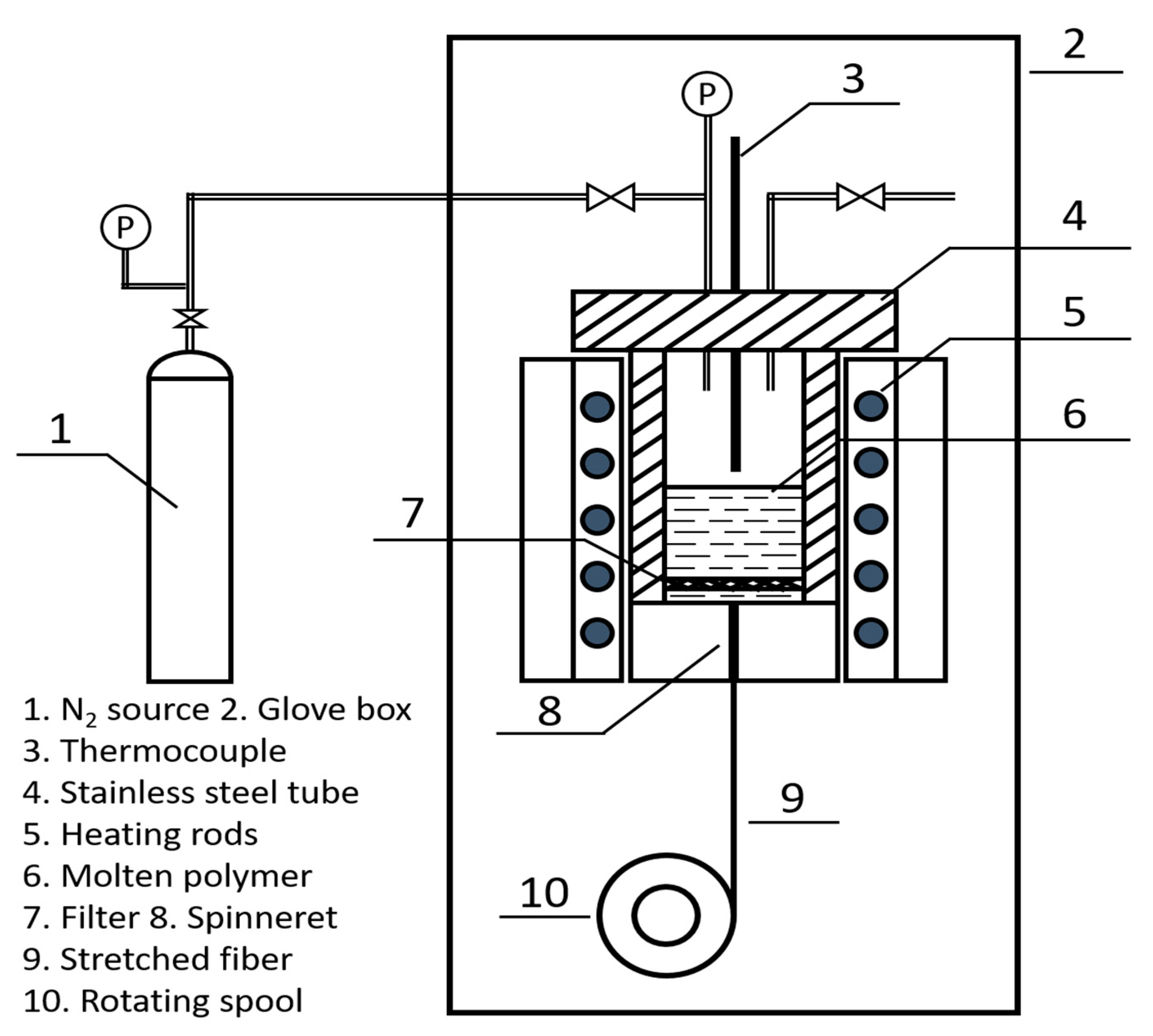
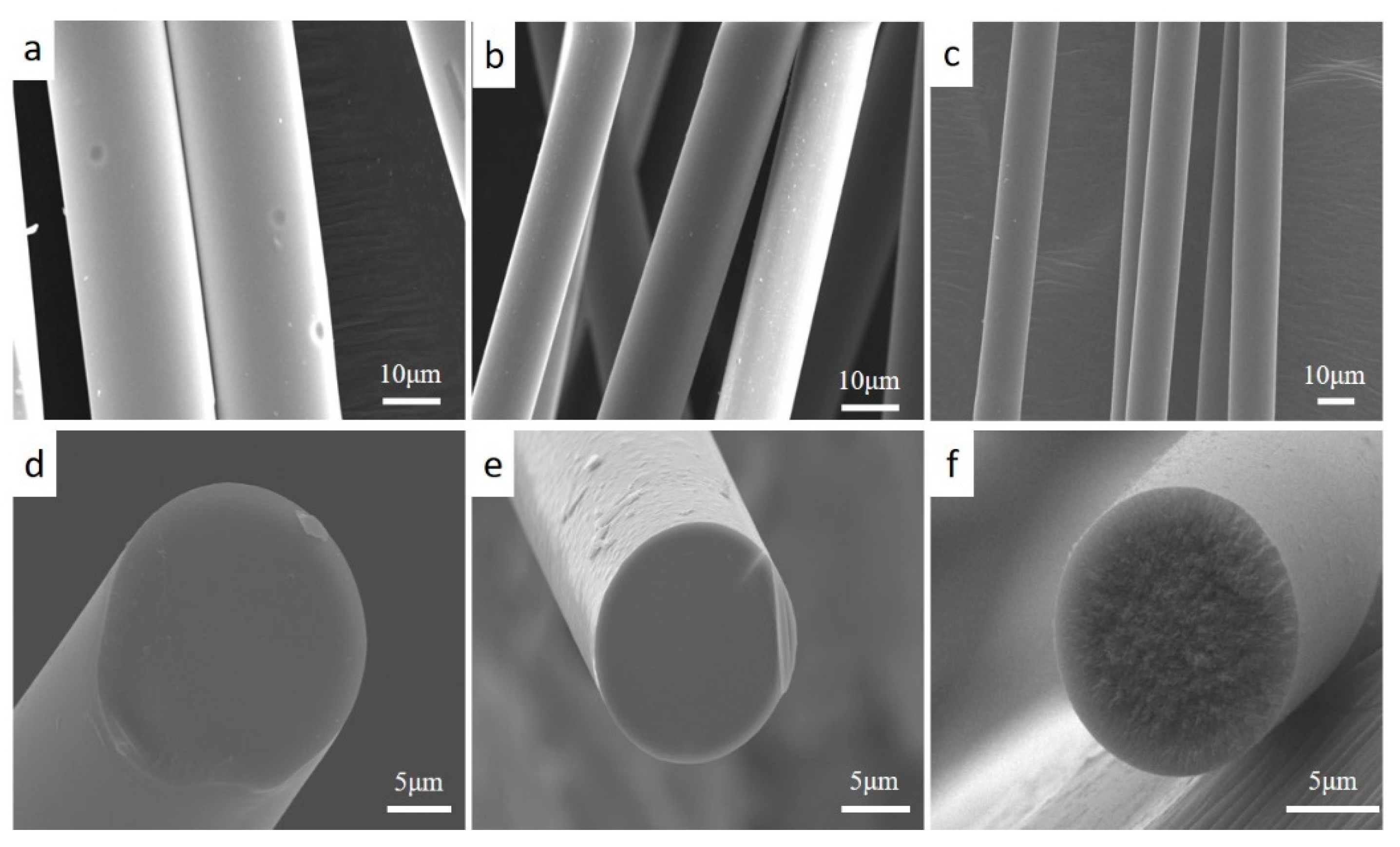

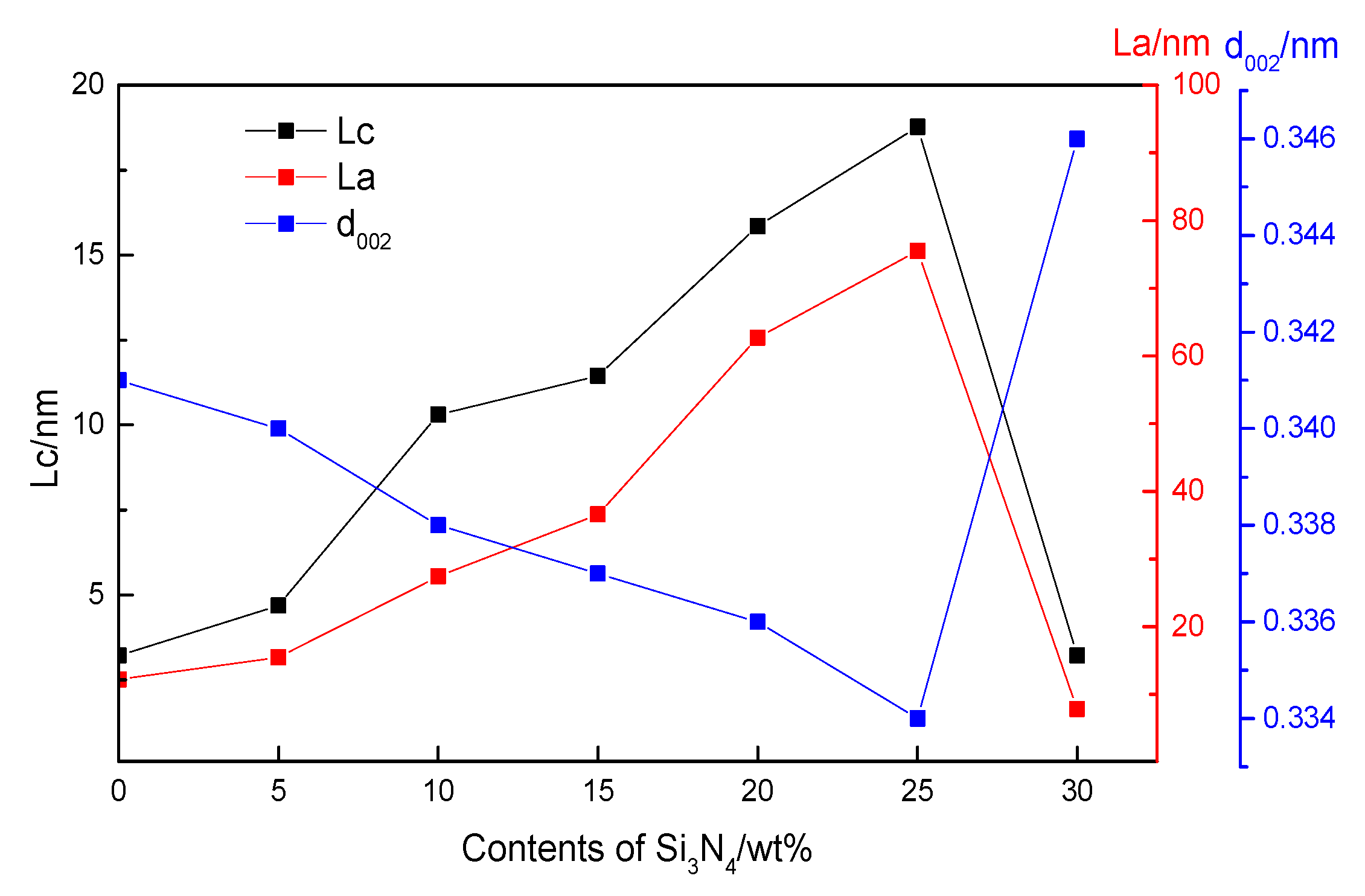
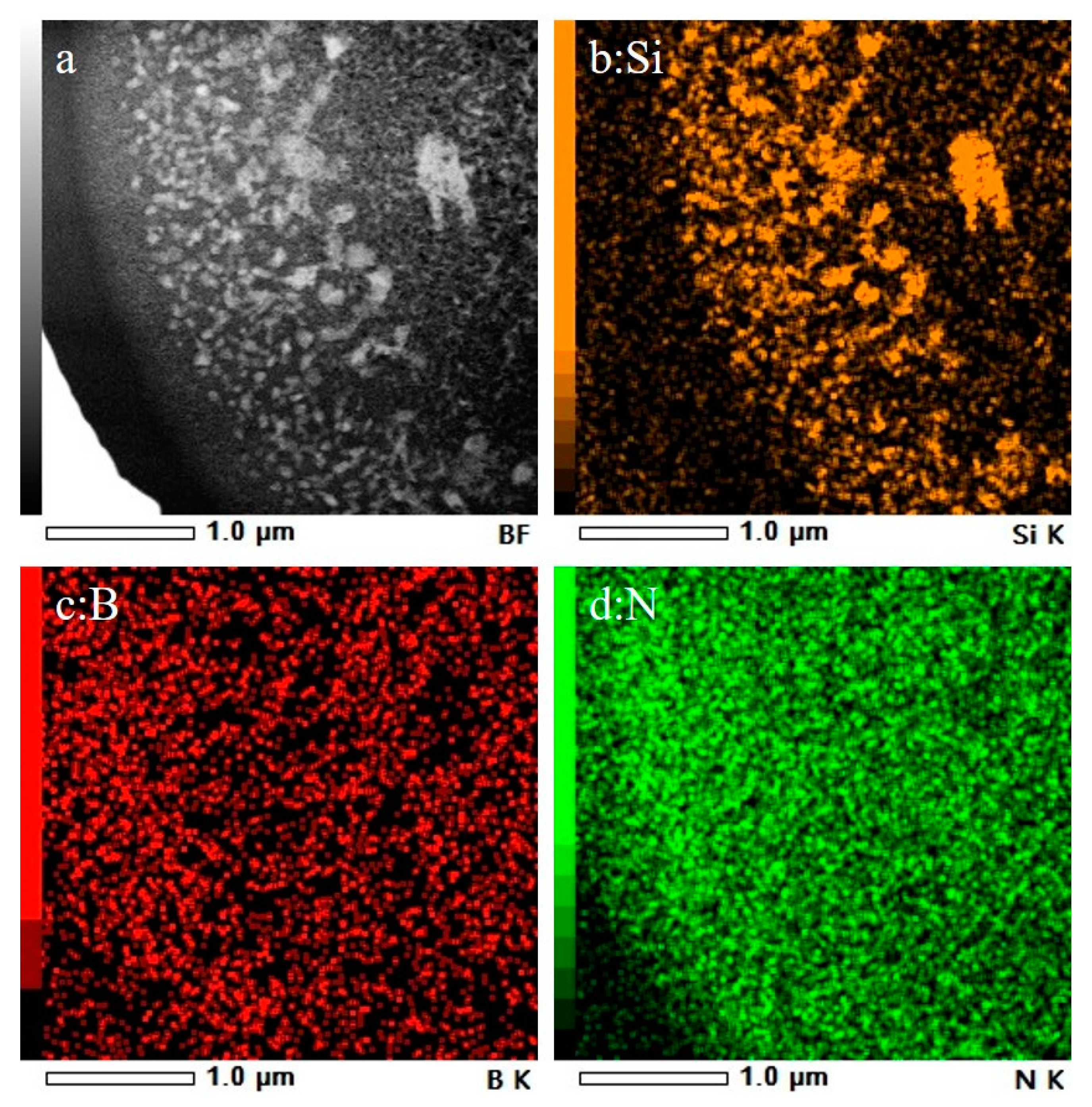
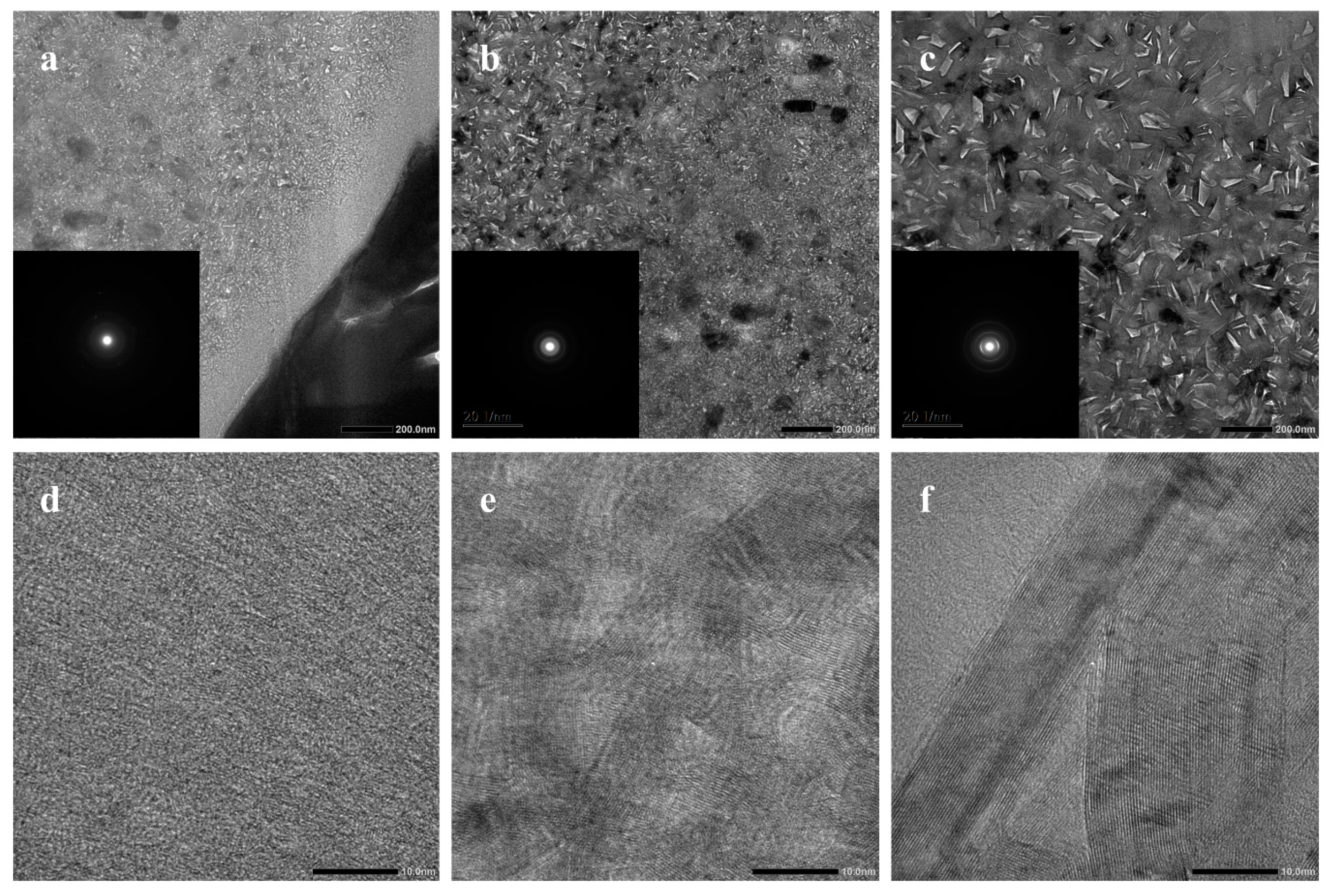

| Elemental Content (wt%) | Si | B | C | H | N |
|---|---|---|---|---|---|
| Green fibers | 6.2 | 19.8 | 22.9 | 7.6 | 43.5 |
| Fibers at 1000 °C | 12.3 | 34.0 | 0.3 | 1.8 | 51.6 |
| Fibers at 1600 °C | 12.6 | 34.5 | 0.2 | 0 | 52.7 |
| Samples | Tensile Strength/MPa | Young’s Modulus/GPa | Failure Strain/% |
|---|---|---|---|
| BN fiber | 720 | 42 | 1.71 |
| Composite fiber | 1040 | 90 | 1.15 |
| Samples | Dielectric Constant | tanδ |
|---|---|---|
| BN fiber | 2.98 | 1.30 × 10−3 |
| Composite fiber | 3.06 | 2.94 × 10−3 |
| Quartz fiber | 3.12 | 3.60 × 10−3 |
| SiBN fiber | 4.36 | 4.20 × 10−3 |
© 2019 by the authors. Licensee MDPI, Basel, Switzerland. This article is an open access article distributed under the terms and conditions of the Creative Commons Attribution (CC BY) license (http://creativecommons.org/licenses/by/4.0/).
Share and Cite
Tan, J.; Ge, M.; Yu, S.; Lu, Z.; Zhang, W. Microstructures and Properties of Ceramic Fibers of h-BN Containing Amorphous Si3N4. Materials 2019, 12, 3812. https://doi.org/10.3390/ma12233812
Tan J, Ge M, Yu S, Lu Z, Zhang W. Microstructures and Properties of Ceramic Fibers of h-BN Containing Amorphous Si3N4. Materials. 2019; 12(23):3812. https://doi.org/10.3390/ma12233812
Chicago/Turabian StyleTan, Jing, Min Ge, Shouquan Yu, Zhenxi Lu, and Weigang Zhang. 2019. "Microstructures and Properties of Ceramic Fibers of h-BN Containing Amorphous Si3N4" Materials 12, no. 23: 3812. https://doi.org/10.3390/ma12233812




